Rip clean is my last resort option. I cleaned all the sand I could access in the tank without removing the rocks and coralsThats a good start, but I REALLY think you either need to rip clean or 100% vacuum sand.
Navigation
Install the app
How to install the app on iOS
Follow along with the video below to see how to install our site as a web app on your home screen.
Note: This feature may not be available in some browsers.
More options
You are using an out of date browser. It may not display this or other websites correctly.
You should upgrade or use an alternative browser.
You should upgrade or use an alternative browser.
0 nitrates and .02 phosphates but tank overwhelmed by Green hair algae
- Thread starter JustAnt
- Start date
- Tagged users None
- Joined
- Feb 7, 2020
- Messages
- 91
- Reaction score
- 58
"Fluconazole" no water change 3-4 week treatment works wonders and its reef safe. Sometimes hydrogen peroxide dips don't work with some frags so i'll monitor the gha until my cuc cant handle it anymore. Works really well against bryopsis as well.
Fluconazole worked for me in the past for bryopsis. I've used vibrant for GHA and it also works. Just have to stay on top of the nutrients that are put back in the tank after die off. This strategy coupled with manual removal of as much as possible helped turn the tide. It did take a while.
Test kits used: api nitrate test kit and Hanna phosphate checker.
Source water: tap water run through a 6 stage BRS RODI filter. Zero TDS
Tank: Reefer 250 so with sump it’s about 65 gallons. Run a skimmer (nyos) a bag of carbon in sump and filter floss. Tank is mature; about 4 years old.
I run a mixed reef with 5 fish 10+ corals. I feed about 2 cubes of mysis a week for the past 6 months to try to reduce algae (didn’t work)
I have 2 HD primes by AI on the tank. I reduced the photo period from 10 hrs to about 8 hours to try to reduce algae growth- didn’t work.
I have read up on this issue and it appears many reef keepers have run into the problem I’m having. It was even described in a BRS video. The reason why the nitrates and phosphates are low AND I have GHA is likely that the large amount of GHA is consuming the nitrates and phosphates giving a reading of zero. I believe this is what I’m experiencing. Problem is I don’t know how to fix it.
Today I manually removed as much algae as possible. Other than manually pulling out the hair algae the only other step I took was to start dosing 2ml of nopox.
Any recommendations to solve the problem? Thanks in advance.
following. Having the same issue.
Why battling phosphate? If the phosphate content is doubled ( leaked from rock?), will algae grow faster an or better? if they do, is it a good or a bad thing? Does it depend on other nutrients being available? if algae grow better when only the phosphate content is increased, phosphorus may be considered to be the limiting factor for growth, a situation I would try to avoid in a reef aquarium. If another essential nutrient is limiting growth it will be shown by the phosphate level if phosphorus is leaked from the rock. The growth rate of algae is mainly driven by the nitrogen source used ( considering light is coral oriented), and the availability of other essential substances to support that growth. The use of nitrate-nitrogen instead of ammonium-nitrogen slows down growth. (+- x5)
Must phosphate be held responsible for increased algae growth or do we better focus on nitrogen availability? Phosphate does influence coral growth, increases the calcification rate, but more important is it is available! ref: http://www.baharini.eu/baharini/doku.php?id=nl:makazi:chemie:calcificatie#calcificatie_bij_koralen
I would try to keep a measurable Phosphate reserve at all times while limiting the nitrogen reserve below x 10 in weight as nitrate. This means 0.02 ppm phosphate, max <0.2ppm nitrate or better 0.2 ppm and < 2ppm nitrate.
In this tank, phosphorus seems not to be the limiting factor, keep it that way!
First, the algae must be harvested as much as possible. The nutrient levels should rise as the algae can not consume it. One may also follow what happens if the skim rate is reduced. Nitrate should become detectable. But not when NOPOX is used.
If nitrate is not measured one has no idea of the daily nitrate overproduction, some may be used, some may be exported, the level will not show.
if NOPOX is used, ammonium-nitrogen is used for fast heterotrophic growth, outcompeting other organisms for nutrients and nitrification is build off. Is there enough nitrogen and phosphorus available to use up the NOPOX dose without harming the corral holobiont?. Does the phosphate level stay detectable? If the NOPOX is not used up due to heterotrophic growth limitations, adding more may create a for corrals very dangerous situation. As the nitrate level was not measurable the only usable parameter is the phosphate level. Adding more organic carbon as may be consumed may create a very unhealthy environment for corals and its holobiont. If the phosphate level becomes undetectable I would stop adding NOPOX immediately, in fact, I would never add carbohydrate-based supplements without a very good reason.
How much protein can be produced by adding 2ml NOPOX? And is what needed available? How much nitrogen and phosphorus are needed to consume 2ml NOPOX, daily? Is the phosphorus reserve adequate? Something one should know before starting adding a product that is organic carbon-based. If the phosphorus reserve does not go down one may consider the doses are not used up due to other growth-limiting factors and dosing must be stopped to prevent the accumulation of the product. Carbohydrate accumulation is considered not reef-safe! ref: http://www.baharini.eu/baharini/doku.php?id=en:makazi:het_water:filtratie:vodka
It may take a long time before algae show a nutrient deficiency, some are able to loos 50 % biomass before starting dying off. What do you think a coral and its symbiodinium will do in such a situation? ref: http://www.baharini.eu/baharini/doku.php?id=nl:makazi:theorie:koraalverbleking.
Thanks @Belgian Anthias
FANTASTIC Post!!
Those articles that I chewed through slowly left me convinced/enlightened that additives such as NoPox, Vodka are dangerous in the long run, and can cause more harm then good if not used to percision even for short term.
Glad I never got into using NoPox which I considered briefly but then dropped the idea/risk.
If It was me, I would:
1. increase water changes
2. Add lots of herbivores. Big turbos, specifically. A lot of snails. You can put in a tuxedo or similar urchin. Even the most pristine wild reef would be overrun with algae without herbivores.
And that is absolutely all I would do.
I agree. It's what I ultimately did, and it's the thing that worked after nothing else did.
During water changes, I siphoned out large masses of algae. The nutrient levels in the tank now are higher than they read when I had a hair algae infestation. But there's not the slightest bit of nuisance algae to be seen in the display now, nor for the past 10 years or more.
It's not a quick fix at all. But it does seem to be permanent.
Pls post current update full tank shot for this reef @JustAnt
the initial pics here have markers for eutrophication in place; the darker collection zones in the lower portions
we want to assess how adding detritus into the system via target dieoff if any has factored into current sinks in the tank
an update pic will really help us chart changes over this last month and match to actions taken
am interested in seeing the lower portions of the tank, the rock algae portion is easy to fix in one hour but that zone developing or not is special
the initial pics here have markers for eutrophication in place; the darker collection zones in the lower portions
we want to assess how adding detritus into the system via target dieoff if any has factored into current sinks in the tank
an update pic will really help us chart changes over this last month and match to actions taken
am interested in seeing the lower portions of the tank, the rock algae portion is easy to fix in one hour but that zone developing or not is special
Last edited:
Here are some current pics. This is after I had hand removed most algae last week. Yesterday I added a cuc including Mexico turbo snails. I also plan on changing another 12 gallons of water in the next couple of days.Pls post current update full tank shot for this reef @JustAnt
the initial pics here have markers for eutrophication in place; the darker collection zones in the lower portions
we want to assess how adding detritus into the system via target dieoff if any has factored into current sinks in the tank
an update pic will really help us chart changes over this last month and match to actions taken
am interested in seeing the lower portions of the tank, the rock algae portion is easy to fix in one hour but that zone developing or not is special
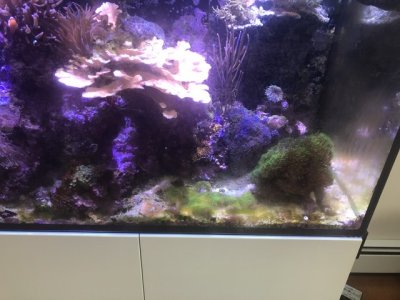
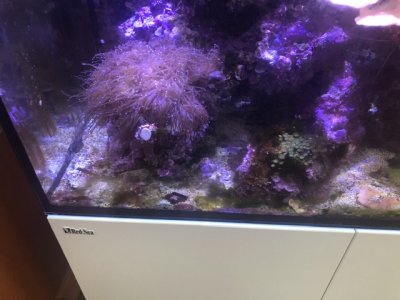
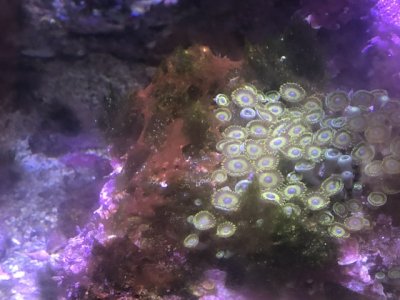
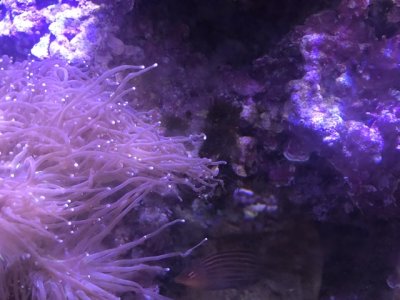
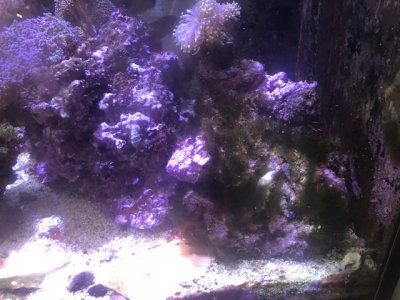
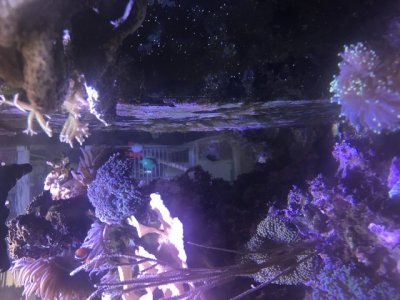
I read through some of the suggested Ideas.
I vote (if possible) to Clean the Rocks (scrub them), and you may have to do it more than once.
** NOT plucking, pruming, or scrubbing GHA off IN YOUR TANK, but Rocks Removed**
This was my old 65 Gal Tank during my GHA Peak.
All caused by overfeedin my Tank, and having the Red Specrum of LED too High.
It went from Clean Rocks (for 1 year) , then to Cyano, to GHA Algae Bloom very quickly.

I had same problem you did, my PO4 was 0.00 (on test kits), but the Algae was consuming the Phosphate.
I can't remember Nitrate since I was so focused on Phosphates.
My (theory) is rocks were leaching out the Phosphate, thus the GHA on Rock, not Sandbed (since I kept my Sandbed well maintained...not me a DiamondWatch Goby that would clean it like crazy)
I tried Every possible snail, even tested the snail is a separate Tank (on sample rocks).
Nothing except a Cowrie and the Ninja Snails. But they couldn't keep up, and I learned the Tiger Cowrie also love Corals. (I still have him confined to sump)

The Middle SeaHare would devour a whole rock of GHA overnight, but it died.
Ever seen a Seahare Polish off a rock loaded with GHA (in few minutes, sped up in TimeLapse)
BURP!!
That's a TimeLapse Video. 1 minute or 5mins per frame (I forget which).
Too bad he died. (next day after this video). My friend got one a few weeks ago. He clean for two days and also died.
The only solution was to take out the Rocks, scrub them, and put them back.
Tank went from This. (this was after many attempt to pluck/prune/brush scrub GHA in tank for weeks)

To this (after 2 ROCK SCRUBBING, """""OUTSIDE OF TANK in BINS"", with good rinse before putting back)

Exact same rocks. A few weeks later. May that photo even was two days after last scrubbing.
The coraline didn't come later, it was under the GHA.
THE GHA never came back EVER. Been Years.
I never used GFO, nor did I ever get into NoPox since (i read) if not used properly can crash your tank. Plus once you start using NoPox you can't just stop, you must wean off the tank.
Of course stopped over feeding Corals, fish, and limited RED light to minimal.
And a year or so later I built an Algae Scrubber, which I use to this day (grows Cheato, not Hair Algae)
One thing I learned that I want to pass on is this.
Before I decided to remove the rocks for a scrubbing, I make a device to Blast the GHA like a lawn whipper snipper, and siphon it thru a sock. But to siphon I needed lots of time, so the sock was in my Sump for continuus running. It caught the particulate GHA, but not the liquified GHA.
My PO4 sky rocketed beyond any test kit.
The point is the GHA is loaded with Phosphates, so you have to remove the matter. Adding chemical may kill the GHA but there must be an export, or the PO4 will cycle and cause new GHA to grow back. (Not scientifically proven, but that was my observation). Only Success was GHA removal (outside of tank)
All the best.
You can beat the GHA in your Tank, if I manage to fix what I called "A Tropical Rainforest GHA outbreak:
Question
If the rocks have coral on them . How long can the rocks be scrubbed for outside the tank? How long can they be out of water? and how long exposed to air?
If you have GHA in cracks and crevices of the rock how did you scrub that out . Most spots I cant even get a tootbrush in where my current GHA is growing .
Sorry for late reply. Never noticed this question.Question
If the rocks have coral on them . How long can the rocks be scrubbed for outside the tank? How long can they be out of water? and how long exposed to air?
If you have GHA in cracks and crevices of the rock how did you scrub that out . Most spots I cant even get a tootbrush in where my current GHA is growing .
Unfortunately. You have to remove corals before you take out rocks for scrubbing. Most corals except encrusted SPS are easily removable. You want to do a good job on the scrubbing, rinsing.
For nooks and crannies, get a very stiff (non metal) brush, it will scrub deep enough into where GHA grows.
Maybe even a soft cloth wipe with Hydrogen Peroxide since it really kills the GHA film. However when rubbing with peroxide quickly rinse with salt water. Soak rock in clean salt water before putting back into Tank.
Thanks I will try to remove the corals before taking the rocks out for a scrub . I did 1 test rock a couple weeks ago and nothing has grown on it since so I have been hopeful that if I scrub all the rocks then maybe the GHA will be gone for now .Sorry for late reply. Never noticed this question.
Unfortunately. You have to remove corals before you take out rocks for scrubbing. Most corals except encrusted SPS are easily removable. You want to do a good job on the scrubbing, rinsing.
For nooks and crannies, get a very stiff (non metal) brush, it will scrub deep enough into where GHA grows.
Maybe even a soft cloth wipe with Hydrogen Peroxide since it really kills the GHA film. However when rubbing with peroxide quickly rinse with salt water. Soak rock in clean salt water before putting back into Tank.
Similar threads
- Replies
- 5
- Views
- 147
- Replies
- 9
- Views
- 237
- Replies
- 7
- Views
- 162
- Replies
- 4
- Views
- 128
















